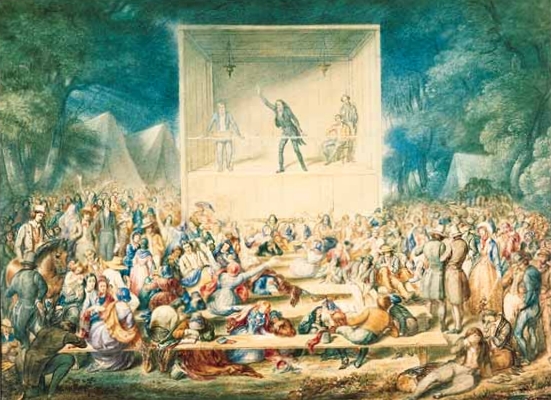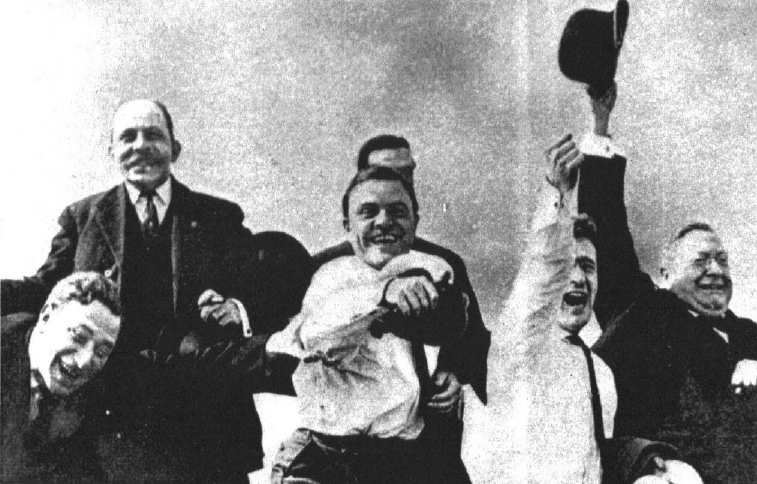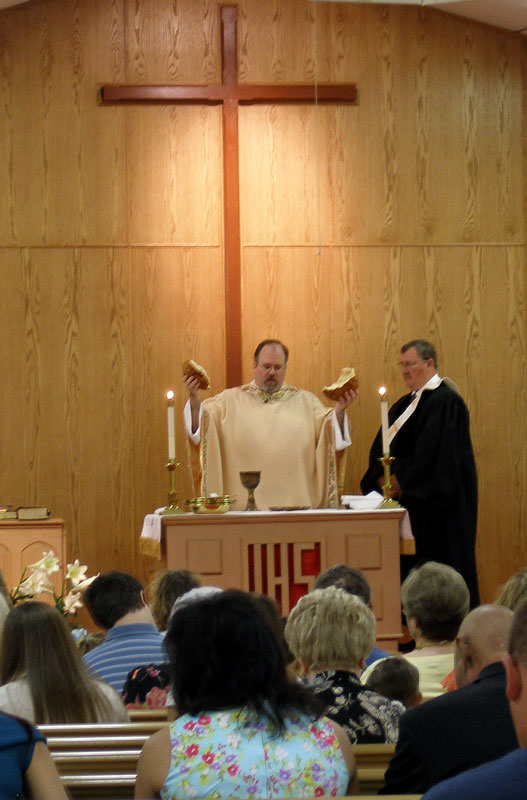|
The American Religion
''The American Religion: The Emergence of the Post-Christian Nation'' (1992; second edition 2006) is a book by literary critic Harold Bloom, in which the author covers the topic of religion in the United States from a perspective which he calls ''religious criticism''. Religious denominations Bloom discusses include the Church of Jesus Christ of Latter-day Saints, Christian Science, the Seventh-day Adventist Church, Jehovah's Witnesses, and the Southern Baptist Convention. Summary Bloom lays out his conception of a practice of ''religious criticism'', by which he does not mean criticism of religion. He distinguishes the practice from other aspects of religious studies (e.g., history of religion or philosophy of religion) by analogy with his practice of literary criticism. Bloom says, literary criticism involves aspects of history ''et cetera'', but is distinguished by having a focus on aesthetic judgments concerning literature. Bloom's religious criticism thus will involve hi ... [...More Info...] [...Related Items...] OR: [Wikipedia] [Google] [Baidu] |
Harold Bloom
Harold Bloom (July 11, 1930 – October 14, 2019) was an American literary critic and the Sterling Professor of Humanities at Yale University. In 2017, Bloom was described as "probably the most famous literary critic in the English-speaking world." Following the publication of his first book in 1959, Bloom wrote more than 50 books, including over 40 books of literary criticism, several books discussing religion, and a novel. During his lifetime, he edited hundreds of anthologies concerning numerous literary and philosophical figures for the Chelsea House publishing firm. Bloom's books have been translated into more than 40 languages. Bloom was elected to the American Philosophical Society in 1995. Bloom was a defender of the traditional Western canon at a time when literary departments were focusing on what he derided as the "school of resentment" ( multiculturalists, feminists, Marxists, and others). He was educated at Yale University, the University of Cambridge, and Co ... [...More Info...] [...Related Items...] OR: [Wikipedia] [Google] [Baidu] |
United States Of America
The United States of America (U.S.A. or USA), commonly known as the United States (U.S. or US) or America, is a country primarily located in North America. It consists of 50 states, a federal district, five major unincorporated territories, nine Minor Outlying Islands, and 326 Indian reservations. The United States is also in free association with three Pacific Island sovereign states: the Federated States of Micronesia, the Marshall Islands, and the Republic of Palau. It is the world's third-largest country by both land and total area. It shares land borders with Canada to its north and with Mexico to its south and has maritime borders with the Bahamas, Cuba, Russia, and other nations. With a population of over 333 million, it is the most populous country in the Americas and the third most populous in the world. The national capital of the United States is Washington, D.C. and its most populous city and principal financial center is New York City. Paleo ... [...More Info...] [...Related Items...] OR: [Wikipedia] [Google] [Baidu] |
Afterword
An afterword is a literary device that is often found at the end of a piece of literature. It generally covers the story of how the book came into being, or of how the idea for the book was developed. An afterword may be written by someone other than the author of the book to provide enriching comment, such as discussing the work's historical or cultural context (especially if the work is being reissued many years after its original publication). See also * Conclusion * Epilogue * Foreword * Postface A postface is the opposite of a preface, a brief article or explanatory information placed at the end of a book A book is a medium for recording information in the form of writing or images, typically composed of many pages (made of p ... * Postscript References {{Book structure Book design Literature ... [...More Info...] [...Related Items...] OR: [Wikipedia] [Google] [Baidu] |
Simon & Schuster
Simon & Schuster () is an American publishing company and a subsidiary of Paramount Global. It was founded in New York City on January 2, 1924 by Richard L. Simon and M. Lincoln Schuster. As of 2016, Simon & Schuster was the third largest publisher in the United States, publishing 2,000 titles annually under 35 different imprints. History Early years In 1924, Richard Simon's aunt, a crossword puzzle enthusiast, asked whether there was a book of ''New York World'' crossword puzzles, which were very popular at the time. After discovering that none had been published, Simon and Max Schuster decided to launch a company to exploit the opportunity.Frederick Lewis Allen, ''Only Yesterday: An Informal History of the 1920s'', p. 165. . At the time, Simon was a piano salesman and Schuster was editor of an automotive trade magazine. They pooled , equivalent to $ today, to start a company that published crossword puzzles. The new publishing house used "fad" publishing to publish bo ... [...More Info...] [...Related Items...] OR: [Wikipedia] [Google] [Baidu] |
Cane Ridge
Cane Ridge was the site, in 1801, of a huge camp meeting that drew thousands of people and had a lasting influence as one of the landmark events of the Second Great Awakening, which took place largely in frontier areas of the United States. The event was led by eighteen Presbyterian ministers, but numerous Methodist and Baptist preachers also spoke and assisted. Many of the "spiritual exercises", such as glossolalia and ecstatic attendees, were exhibited that in the 20th century became more associated with the Pentecostal movement. Cane Ridge is located in Bourbon County, Kentucky Bourbon County is a county located in the U.S. state of Kentucky. As of the 2020 census, the population was 20,252. Its county seat is Paris. Bourbon County is part of the Lexington–Fayette, KY Metropolitan Statistical Area. It is one of Ken ..., near Paris, Kentucky, Paris. The ridge was named by the explorer Daniel Boone, who had noticed a form of bamboo growing there. The Cane Ridge buildin ... [...More Info...] [...Related Items...] OR: [Wikipedia] [Google] [Baidu] |
Second Great Awakening
The Second Great Awakening was a Protestant religious revival during the early 19th century in the United States. The Second Great Awakening, which spread religion through revivals and emotional preaching, sparked a number of reform movements. Revivals were a key part of the movement and attracted hundreds of converts to new Protestant denominations. The Methodist Church used circuit riders to reach people in frontier locations. The Second Great Awakening led to a period of antebellum social reform and an emphasis on salvation by institutions. The outpouring of religious fervor and revival began in Kentucky and Tennessee in the 1790s and early 1800s among the Presbyterians, Methodists and Baptists. It led to the founding of several well known colleges, seminaries, and mission societies. Historians named the Second Great Awakening in the context of the First Great Awakening of the 1730s and 1750s and of the Third Great Awakening of the late 1850s to early 1900s. The First ... [...More Info...] [...Related Items...] OR: [Wikipedia] [Google] [Baidu] |
Gnosticism
Gnosticism (from grc, γνωστικός, gnōstikós, , 'having knowledge') is a collection of religious ideas and systems which coalesced in the late 1st century AD among Jewish Jews ( he, יְהוּדִים, , ) or Jewish people are an ethnoreligious group and nation originating from the Israelites Israelite origins and kingdom: "The first act in the long drama of Jewish history is the age of the Israelites""The ... and early Christian sects. These various groups emphasized personal spiritual knowledge (''gnosis'') above the orthodox teachings, traditions, and authority of religious institutions. Gnostic cosmogony generally presents a distinction between a supreme, hidden God and a malevolent demiurge, lesser divinity (sometimes associated with the Yahweh of the Old Testament) who is responsible for creating the nature, material universe. Consequently, Gnostics considered material existence flawed or evil, and held the principal element of salvation to be direct ... [...More Info...] [...Related Items...] OR: [Wikipedia] [Google] [Baidu] |
Christianity
Christianity is an Abrahamic monotheistic religion based on the life and teachings of Jesus of Nazareth. It is the world's largest and most widespread religion with roughly 2.38 billion followers representing one-third of the global population. Its adherents, known as Christians, are estimated to make up a majority of the population in 157 countries and territories, and believe that Jesus is the Son of God, whose coming as the messiah was prophesied in the Hebrew Bible (called the Old Testament in Christianity) and chronicled in the New Testament. Christianity began as a Second Temple Judaic sect in the 1st century Hellenistic Judaism in the Roman province of Judea. Jesus' apostles and their followers spread around the Levant, Europe, Anatolia, Mesopotamia, the South Caucasus, Ancient Carthage, Egypt, and Ethiopia, despite significant initial persecution. It soon attracted gentile God-fearers, which led to a departure from Jewish customs, and, a ... [...More Info...] [...Related Items...] OR: [Wikipedia] [Google] [Baidu] |
Enthusiasm
In modern usage, enthusiasm refers to intense enjoyment, interest, or approval expressed by a person. The term is related to playfulness, inventiveness, optimism and high energy. The word was originally used to refer to a person possessed by God, or someone who exhibited intense piety. Historical usage The word ''enthusiasm'' originates from the Greek ἐνθουσιασμός from ἐν (en, “in”) and θεός (theós, “god”) and οὐσία (ousía, “essence”), meaning "inspired by god's essence". Applied by the Greeks to manifestations of divine possession, by Apollo (as in the case of the Pythia), or by Dionysus (as in the case of the Bacchantes and Maenads), the term enthusiasm was also used in a transferred or figurative sense. Socrates taught that the inspiration of poets is a form of enthusiasm. The term was confined to a belief in religious inspiration, or to intense religious fervor or emotion. From this, a Syrian sect of the fourth century was know ... [...More Info...] [...Related Items...] OR: [Wikipedia] [Google] [Baidu] |
Roman Catholicism
The Catholic Church, also known as the Roman Catholic Church, is the List of Christian denominations by number of members, largest Christian church, with 1.3 billion baptized Catholics Catholic Church by country, worldwide . It is among the world's oldest and largest international institutions, and has played a prominent role in the history and development of Western civilization.Gerald O'Collins, O'Collins, p. v (preface). The church consists of 24 Catholic particular churches and liturgical rites#Churches, ''sui iuris'' churches, including the Latin Church and 23 Eastern Catholic Churches, which comprise almost 3,500 dioceses and Eparchy, eparchies located List of Catholic dioceses (structured view), around the world. The pope, who is the bishop of Rome, is the Papal supremacy, chief pastor of the church. The bishopric of Rome, known as the Holy See, is the central governing authority of the church. The administrative body of the Holy See, the Roman Curia, has its pr ... [...More Info...] [...Related Items...] OR: [Wikipedia] [Google] [Baidu] |
Mainline Protestantism
The mainline Protestant churches (also called mainstream Protestant and sometimes oldline Protestant) are a group of Protestant denominations in the United States that contrast in history and practice with evangelical, fundamentalist, and charismatic Protestant denominations. Some make a distinction between "mainline" and "oldline", with the former referring only to denominational ties and the latter referring to church lineage, prestige and influence. However, this distinction has largely been lost to history and the terms are now nearly synonymous. Mainline Protestant churches have stressed social justice and personal salvation, and both politically and theologically, tend to be more liberal than non-mainstream Protestants. Mainstream Protestant churches share a common approach that often leads to collaboration in organizations such as the National Council of Churches, and because of their involvement with the ecumenical movement, they are sometimes given the alternative label ... [...More Info...] [...Related Items...] OR: [Wikipedia] [Google] [Baidu] |
Pentecostalism
Pentecostalism or classical Pentecostalism is a Protestant Charismatic Christian movement"Spirit and Power: A 10-Country Survey of Pentecostals" The Pew Forum on Religion and Public Life. that emphasizes direct personal experience of through . The term ''Pentecostal'' is derived from |




.jpg)

